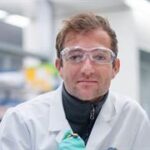2025;
Choi JS, Pervin M, Vince JE, Sharma A, de Haan JB. Targeting the NLRP3 Inflammasome-Gasdermin D Axis to Combat Cardiovascular Diseases. Journal of Molecular and Cellular Cardiology. 2025;209:10.1016/j.yjmcc.2025.09.006
Shah SS, Manning JA, Lim Y, Sinha D, Murthy AMV, Ganesan R, Robinson N, Alnemri ES, Masters SL, Vince JE, Kumar S. NEDD4L-mediated Gasdermin D and E ubiquitination regulates cell death and tissue injury. Cell Death & Differentiation. 2025;:10.1038/s41418-025-01598-1
M. Bader S, Scherer L, Bhandari R, Motyer AJ, Cooney JP, Mackiewicz L, Dayton M, Sheerin D, V. L. Romero D, Schaefer J, Pang J, Chen S, Schoffer K, Wang L, Jin X, Batey D, Yip RKH, Zaman I, Rajasekhar P, Gartner MJ, Wilcox S, Whitehead L, Georgy SR, Maluenda A, Davidson KC, Allison CC, Bowden R, Brinkmann K, Asselin-Labat M-L, Phipson B, Tanzer MC, Herold MJ, Samson AL, Vince JE, Strasser A, Pellegrini M, Doerflinger M. Non-apoptotic caspase-8 is critical for orchestrating exaggerated inflammation during severe SARS-CoV-2 infection. Nature Communications. 2025;16(1):10.1038/s41467-025-65098-z
Vince JE, Davidson NM, Tanzer MC. Necroptotic cell death consequences and disease relevance. Nature Immunology. 2025;26(11):10.1038/s41590-025-02298-1
Deepagan VG, Ma X, Bazregari F, Pang J, Schaefer J, Hildebrand JM, Dempsey RK, Doerflinger M, Baldwin CA, Schmidt FI, Murphy JM, Salvamoser R, Vince JE. Lipid nanoparticle-delivered intrabodies for inhibiting necroptosis and pyroptosis. Biochemical Journal. 2025;482(16):10.1042/bcj20253191
Choi J, Donner D, Kiriazis H, Brown A, Pervin M, Yavari P, Vince J, Sharma A, de Haan J. Selectively Targeting the Dasdermin-D Pore Attenuates Inflammation and Fibrosis in the Heart After Ischemia Reperfusion Injury. Heart Lung and Circulation. 2025;34:10.1016/j.hlc.2025.06.837
Shojaee F, Azadian E, Wong MX, Ma X, Rickard J, Pang J, Hall C, Kueh AJ, Masters SL, Rioja I, Prinjha RK, Doerflinger M, Lawlor KE, Rashidi M, Vince JE. NLRP3 inflammasome–driven hemophagocytic lymphohistiocytosis occurs independent of IL-1β and IL-18 and is targetable by BET inhibitors. Science Advances. 2025;11(28):10.1126/sciadv.adv0079
Choi J, Donner D, Kiriazis H, Brown A, Parvin M, Yavari P, Vince J, Sharma A, de Haan JB. Targeting the inflammatory Gasdermin-D pore improves cardiac ischemia reperfusion injury in mice. Free Radical Biology and Medicine. 2025;233:10.1016/j.freeradbiomed.2025.05.066
Al-Ani A, Pang J, Patel K, Young S, Kong I, Chen J-J, Barrios M, Rickard J, Chen S, Foroughi S, Cawthorne W, Jacobsen A, Jois A, Weir A, Whitehead L, Rajasekhar P, Horne C, Azeez I, Tan T, Liang W, Sivanesan S, Metz A, Patwardhan A, Shea N, Iyngkaran G, Schneider D, Elford A, Beattie W, Macrae FA, Liccardi G, Walczak H, Zhang Y, Sieber O, Spelman T, Giulino-Roth L, Hawkins E, Rogers K, Bowden R, Nicholson S, Lawlor K, Samson A, Vince J, Murphy JM, Christensen B. Su1887: CELL DEATH DYSREGULATION IS A MOLECULAR HALLMARK OF INFLAMMATORY BOWEL DISEASE (IBD). Gastroenterology. 2025;169(1):10.1016/s0016-5085(25)02948-8





